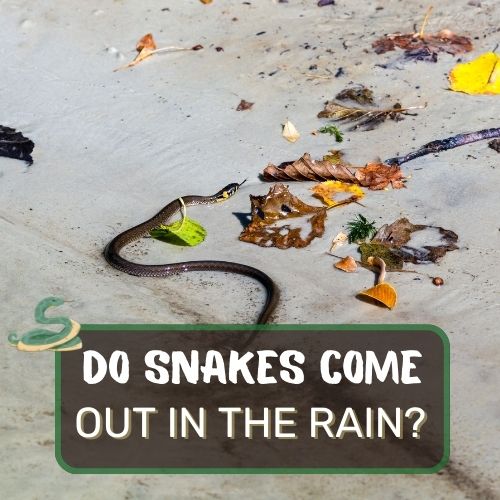
Are you curious about the intriguing behavior of snakes during rainfall?
In this article, we will explore the question, “Do snakes come out in the rain?” and delve into the factors that influence their activity in wet weather.
You will gain insights into the relationship between snakes and rain, their adaptations to cope with rainy conditions, and safety tips for encountering snakes during precipitation.
Join us as we unravel the secrets of these slithering reptiles and discover how they respond to the changing environment when the skies open up.
Table of Contents
- 1 Answer To Do Snakes Come Out In The Rain
- 2 Snakes and Rain: A General Overview
- 3 Snakes and Rain: The Scientific Perspective
- 4 Snakes’ Response to Rain: Hunting and Prey
- 5 Snakes’ Response to Rain: Seeking Shelter
- 6 Snake Bites and Rain: The Connection
- 7 Snakes’ Adaptations to Rain
- 8 Urban Snakes and Rain
- 9 Safety Tips: Dealing with Snakes in Rainy Weather
- 10 FAQ
- 11 Conclusion
Answer To Do Snakes Come Out In The Rain
Yes, snakes can come out in the rain, but their behavior during rainy weather may vary depending on the species and other factors. Some snakes are more active during or after rain, taking advantage of the increased prey activity that may occur in wet conditions. They may also use the rain to aid in hunting, as the sound of rain can mask their movements and make it easier to approach prey.
On the other hand, heavy rain or storms can prompt snakes to seek shelter and hide until the weather improves. Snakes prefer to avoid getting wet as it can hinder their movements and affect their ability to hunt effectively.
Overall, the response of snakes to rain depends on various factors, including their natural habitats, the availability of prey, and individual characteristics.
It is essential to remember that most snakes are generally not aggressive towards humans and would prefer to avoid confrontation if given the chance.
It is always best to stay cautious and maintain a safe distance from any snake encountered in the wild.
Snakes and Rain: A General Overview

Importance of Understanding Snake Behavior in Different Weather Conditions
Understanding snake behavior in various weather conditions is crucial for several reasons. Snakes are fascinating creatures, and their interactions with the environment can provide valuable insights into their ecological roles.
By studying how they respond to rain, we can gain a deeper understanding of their survival strategies and overall impact on ecosystems.
Weather plays a significant role in influencing the activity of snakes. Rainy conditions can have both direct and indirect effects on these slithering reptiles.
For instance, changes in temperature and humidity can affect their metabolism and movement patterns.
Snakes might alter their behavior in response to rain, seeking shelter or adjusting their hunting strategies to adapt to the changing environment.
Snakes’ Natural Habitats and Behavior
To truly comprehend why snakes react the way they do to rain, it’s essential to consider their natural habitats and behavior.
Different snake species have evolved to thrive in specific environments, ranging from deserts and grasslands to forests and wetlands. Each habitat presents unique challenges, and snakes have adapted their behavior accordingly.
For instance, snakes inhabiting arid regions may rarely encounter rain, so their reactions to it might differ significantly from those living in rainy climates.
In arid regions, snakes may become more active during the rare rainfall to take advantage of increased prey activity, while in wetter regions, snakes may already be well-adapted to rainy conditions.
Relationship Between Snakes and Rain
The relationship between snakes and rain is complex and multifaceted. Rain can both positively and negatively impact snakes, depending on various factors such as species, habitat, and individual behavior.
In some cases, rain can trigger snake activity.
For example, after a heavy downpour, certain snake species might emerge to bask in the sun as the rain subsides, taking advantage of the warmer conditions.
On the other hand, heavy rain might also force snakes to seek shelter to avoid flooding or to protect themselves from potential predators.
Rain can also influence the availability of prey for snakes. Some prey species might become more active during or after rain, presenting an opportunity for snakes to find food more easily.
Conversely, other prey species may become scarce during rainy periods, leading to shifts in snake hunting patterns.
Snakes and Rain: The Scientific Perspective

Research on Snake Behavior During Rainfall
Scientific research on snake behavior during rainfall has provided valuable insights into the complex relationship between these creatures and the weather.
Studies have revealed that different snake species exhibit varied responses to rain, and these responses are influenced by factors such as habitat, temperature, and individual characteristics.
Researchers use a combination of field observations and controlled experiments to study snake behavior in rainy conditions.
By tracking snakes in their natural habitats and simulating rain events in controlled environments, scientists can gather data on how rain affects their movements, activity levels, and hunting behavior.
Additionally, advances in technology have enabled researchers to use radio telemetry and GPS tracking to monitor snakes remotely.
This non-invasive approach allows scientists to gather continuous data on snake behavior during various weather conditions, including rainfall.
Factors That Influence Snake Activity During Rain
- Temperature Regulation: Snakes are ectothermic, meaning they rely on external sources to regulate their body temperature. While rain can cool the environment, if the overall temperature remains warm, snakes might still be active. Conversely, a cold rain can deter them, making them seek shelter.
- Prey Movement: Rain often brings out various prey animals, such as frogs, worms, and insects. Snakes might become more active during or after rain to capitalize on these increased hunting opportunities.
- Hydration Needs: Some snakes absorb moisture through their scales. Rain provides an opportunity for them to hydrate, especially in areas where water sources might be scarce.
- Breeding Patterns: Certain snake species are known to mate during or after rain. The moisture-rich environment can be conducive for egg-laying and the subsequent hatching process.
- Habitat Disruption: Heavy rainfall can flood snake habitats, especially if they’re ground-dwelling or in low-lying areas. This can force them to move, seeking higher ground or alternative shelters.
- Safety and Camouflage: Rain can offer snakes a form of camouflage, making them less detectable to predators. Additionally, the wet conditions can provide a protective barrier against some threats.
Understanding these factors can help in predicting snake behavior during rainy conditions and potentially reduce human-snake conflicts.
Snakes’ Response to Rain: Hunting and Prey

Snakes’ Hunting Behavior During Rain
Rainy weather can significantly affect snakes’ hunting behavior. Some species take advantage of the increased activity of prey species during or after rain, becoming more active in search of food.
The sound of rain can also mask their movements, making it easier for them to approach their prey undetected.
On the other hand, heavy rainfall can pose challenges to snakes during hunting. Excess water can flood their usual hunting grounds and displace prey, making it harder for snakes to find food.
In such cases, snakes may opt to seek higher ground or shelter until the rain subsides.
Prey Availability During Rainy Weather
The availability of prey during rainy weather can vary depending on the region and habitat. In some areas, rain can lead to an increase in insect and small mammal activity, providing snakes with ample opportunities to hunt.
For instance, frogs and rodents may become more active during and after rain, attracting snakes to potential feeding spots.
Conversely, heavy rain may lead to a decrease in prey availability. Certain prey species might seek shelter during storms, making them harder for snakes to find.
This scarcity of food can prompt snakes to conserve energy and wait for more favorable hunting conditions.
Snakes’ Response to Rain: Seeking Shelter

Snakes’ Preference for Dry Shelter During Rain
When the rain starts pouring down, snakes, like many other creatures, seek shelter to protect themselves from the elements.
Most snakes prefer dry and covered areas during rainy weather to avoid getting wet, which can have adverse effects on their health and behavior.
Waterlogged scales can hinder a snake’s movements and reduce their ability to hunt effectively. Furthermore, prolonged exposure to rain can lead to health issues like respiratory infections.
To avoid these challenges, snakes instinctively search for suitable hiding spots to wait out the rain.
Common Hiding Spots for Snakes During Rain
Snakes are incredibly resourceful when it comes to finding shelter during rainfall. They tend to gravitate towards areas that offer protection and are relatively dry.
Some common hiding spots for snakes during rain include:
- Rock crevices: Small gaps between rocks or boulders provide excellent cover for snakes seeking shelter from the rain.
- Tree hollows: Arboreal snakes, such as tree-dwelling species, might seek refuge in tree hollows to stay dry during rain.
- Burrows: Many snake species are proficient burrowers, and they will retreat into their underground homes during wet weather.
- Vegetation: Thick vegetation and foliage offer snakes cover from both rain and potential predators.
- Human-made structures: Snakes may utilize human structures like sheds, garages, or abandoned buildings as shelter during rain.
- Underneath objects: Snakes may seek shelter beneath logs, fallen leaves, or debris to avoid getting wet.
In general, snakes are highly adaptable and can quickly identify suitable hiding spots to protect themselves from inclement weather.
Snake Bites and Rain: The Connection

Increase in Snake Bite Incidents During the Rainy Season
One intriguing trend observed by researchers and medical professionals is the increase in snake bite incidents during the rainy season.
While it may seem counterintuitive, the correlation between rain and snake bites can be attributed to various factors.
During the rainy season, the environment undergoes significant changes, impacting both snakes and humans.
As mentioned earlier, snakes tend to become more active in search of prey during or after rain. With an increase in snake activity, the chances of encountering humans also rise.
Reasons Behind the Correlation Between Rain and Snake Bites
Several reasons contribute to the higher incidence of snake bites during the rainy season:
- Human behavior: During rainy periods, people may be more likely to engage in outdoor activities like farming, trekking, or camping. Increased human presence in snake-inhabited areas raises the likelihood of encountering these creatures and, consequently, snake bites.
- Displaced snakes: Heavy rain and flooding can displace snakes from their natural habitats, pushing them into new territories where they may cross paths with unsuspecting humans.
- Reduced visibility: Rainy weather can impair visibility, making it harder for both snakes and humans to detect each other from a distance, leading to inadvertent encounters.
- Agricultural activities: The rainy season often coincides with agricultural activities like planting or harvesting, bringing people closer to snake habitats, which may increase the chances of snake-human interactions.
- Less cautious behavior: Some people may underestimate the risk of encountering snakes during the rain and may not exercise the same caution they would in drier conditions.
Understanding the connection between rain and snake bites is essential for raising awareness and promoting safety measures during the rainy season.
By taking precautions and being mindful of snake habitats, both humans and snakes can coexist more harmoniously, reducing the incidence of snake bites during rainy periods.
Snakes’ Adaptations to Rain

Physical Characteristics That Help Snakes Thrive in Rainy Weather
Here are four physical characteristics that help snakes thrive in rainy weather:
- Scales: A snake’s overlapping scales repel water, preventing them from becoming waterlogged. This allows snakes to move efficiently even in wet conditions.
- Elongated Body: The serpentine shape of snakes aids in swimming and navigating through water. Their streamlined bodies reduce resistance, allowing them to move smoothly in flooded areas.
- Nostril Valves: Many snakes have specialized valves in their nostrils that can close when submerged, preventing water from entering their respiratory system.
- Jacobson’s Organ: This sensory organ allows snakes to detect chemical cues in the environment. In wet conditions, these cues can be more pronounced, aiding in hunting and navigation.
Behavioral Adaptations to Cope With Rain
Here are five behavioral adaptations snakes exhibit to cope with rain:
- Seeking Shelter: Snakes often retreat to burrows, under rocks, or inside logs to avoid heavy rainfall and potential flooding.
- Hunting Behavior: Rain brings out various prey like frogs and worms. Snakes capitalize on this, becoming more active hunters during or post-rain.
- Elevated Movement: In flood-prone areas, snakes might move to higher ground to avoid inundation, ensuring their safety.
- Nocturnal Activity: Some snakes adjust their activity to nighttime during rainy seasons, benefiting from the cooler temperatures and increased prey activity.
- Mating and Breeding: Certain snake species time their breeding activities around rainy seasons, utilizing the moisture-rich environment for egg incubation.
Urban Snakes and Rain

Snakes’ Presence in Urban Areas During Rain
Rain can influence the presence of snakes in urban areas. As natural habitats continue to be encroached upon by urban development, snakes may find themselves in close proximity to human settlements.
During rainy periods, some snakes may venture into urban areas in search of dry shelter and prey.
Abundant food sources in urban environments, such as rodents attracted to garbage, may also draw snakes into cities during rainy weather.
Additionally, stormwater drains and sewers can provide snakes with escape routes during heavy rain or flooding.
Challenges and Risks Associated With Urban Snake Encounters During Rain
While snakes play a crucial role in maintaining ecological balance, encounters with these creatures in urban settings can be concerning for residents.
The presence of venomous snakes can pose potential risks to public safety, especially during the rainy season when snakes may be more active.
During rain, visibility can be reduced, making it difficult for people to spot snakes and react appropriately.
In urban areas, encounters with snakes may lead to panic or attempts to handle the snake, increasing the likelihood of bites and other accidents.
To mitigate risks associated with urban snake encounters during rain, education and awareness are essential. Residents should be informed about local snake species, their behavior, and appropriate safety measures.
Furthermore, ensuring that urban areas are well-maintained, with minimal debris and suitable waste management, can discourage snakes from seeking refuge in human-made structures.
By understanding and respecting snakes’ presence during rainy weather, communities can coexist with these remarkable creatures while taking appropriate precautions to promote safety for both humans and snakes alike.
Safety Tips: Dealing with Snakes in Rainy Weather

Precautions to Minimize Snake Encounters During Rain
Minimizing snake encounters during rainy weather requires a combination of awareness and caution. Here are some safety tips to consider:
- Stay on designated paths: When walking or hiking in natural areas during rain, stick to designated trails and avoid tall grass or dense vegetation, where snakes may seek shelter.
- Watch your step: Pay close attention to where you walk, especially in areas with limited visibility. Avoid stepping over rocks or logs without checking for snakes underneath.
- Wear appropriate clothing: If you’re venturing into snake-prone areas during rain, consider wearing long pants and closed-toe shoes to reduce the risk of snake bites.
- Keep a safe distance: If you encounter a snake during rain, maintain a safe distance and avoid provoking or handling it. Snakes may feel threatened and react defensively if approached closely.
- Clear your surroundings: In urban areas, keep yards and gardens well-maintained, with minimal debris or potential snake hiding spots, to discourage snakes from seeking shelter.
- Secure food sources: Properly dispose of food waste and avoid leaving pet food outside, as these can attract rodents, which, in turn, attract snakes.
What to Do If You Encounter a Snake During Rain
If you encounter a snake during rainy weather, follow these steps to ensure your safety:
- Stay calm: Remain composed and avoid making sudden movements that may startle the snake.
- Back away slowly: Slowly retreat from the snake to create distance between you and the reptile.
- Give the snake space: Snakes usually prefer to avoid confrontation and will likely move away if given enough space.
- Do not attempt to handle or provoke the snake: Even non-venomous snakes can bite if they feel threatened, so it’s best to keep a safe distance.
- Seek medical attention if bitten: If, unfortunately, a snake bites you, seek immediate medical attention, even if you believe the snake is non-venomous. Clean the wound gently and try to remember the snake’s appearance for proper identification.
Remember, most snakes are non-venomous and prefer to avoid humans. By staying aware and taking appropriate precautions, you can minimize the likelihood of snake encounters during rainy weather.
FAQ
What Do Snakes Do When Raining?
During rain, snakes typically seek shelter to stay dry. They may retreat to rock crevices, tree hollows, burrows, or dense vegetation to wait out the rain. Some snakes may become more active to take advantage of increased prey activity during or after rain.
Are Snakes Attracted to Rain?
Snakes are not necessarily attracted to rain itself, but the changes in weather and prey activity that come with rain can influence their behavior. Some species may be more active during or after rain to hunt for prey that becomes more abundant in wet conditions.
What Is the Best Weather to Find Snakes?
The best weather to find snakes depends on the species and its habitat. In general, snakes are more active during warm and mild weather, such as in spring and fall. Sunny days may also increase snake activity as they bask to regulate their body temperature.
What Season Do Snakes Come Out the Most?
Snakes are ectothermic, meaning their activity levels depend on external temperatures. Therefore, they tend to be more active during the warmer months of spring and summer when temperatures are suitable for their metabolism and hunting.
Conclusion
Recap of Key Points Discussed
In this article, we explored the intriguing relationship between snakes and rain. We learned about the importance of understanding snake behavior in different weather conditions, their natural habitats, and how they respond to rainy environments.
We delved into the scientific perspective of snake behavior during rain, their adaptations, and the correlation between rain and snake bites.
Additionally, we discussed safety tips for dealing with snakes in rainy weather and addressed common questions about snakes and rain.
Importance of Coexisting With Snakes and Understanding Their Behavior in Different Weather Conditions
Snakes are essential components of ecosystems, playing vital roles in controlling prey populations and contributing to overall biodiversity.
Understanding their behavior during rainy weather is crucial for coexisting harmoniously with these fascinating creatures.
By being aware of safety measures and precautions, we can minimize the likelihood of snake encounters and reduce the risks associated with such encounters.
Moreover, appreciating their adaptations to rain highlights the adaptability and resilience of snakes, inspiring us to respect their presence and the delicate balance of nature they help maintain.




0 Comments